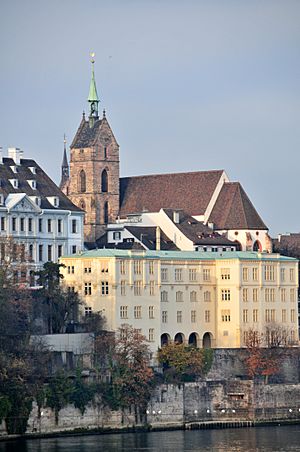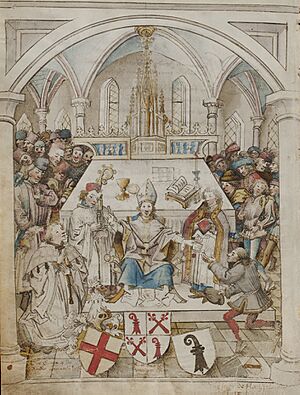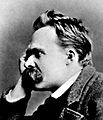University of Basel facts for kids
|
Universität Basel
|
|
 |
|
| Latin: Universitas Basiliensis | |
| Type | Public |
|---|---|
| Established | 4 April 1460 |
| Budget | CHF 768 million (2020) |
| President | Andrea Schenker-Wicki |
|
Academic staff
|
4,700 |
| Students | 13,139 |
| Location |
Basel
,
Basel-City
,
Switzerland
47°33′31″N 07°35′00″E / 47.55861°N 7.58333°E |
| Colours | Mint, Red, Anthracite |
| Affiliations | Utrecht Network, EUCOR |

The University of Basel is a public research university located in Basel, Switzerland. It was founded on April 4, 1460. This makes it Switzerland's oldest university and one of the oldest universities in the world that is still open today. It is known as one of the top places for higher education in Switzerland.
The Basel University Library is connected to the university. It is the largest and one of the most important libraries in Switzerland. The university has many different study areas, like theology, law, medicine, humanities, social sciences, science, psychology, and business. It also has special centers like the Biozentrum for medical research. In 2020, the university had 13,139 students and 378 professors. About 27% of the students came from other countries.
Over its more than 500-year history, many famous people have studied or taught here. These include Erasmus of Rotterdam, Paracelsus, Daniel Bernoulli, Leonhard Euler, Friedrich Nietzsche, and Carl Gustav Jung. The university is also linked to ten Nobel Prize winners and two presidents of Switzerland.
Contents
History of the University
The University of Basel started because of the Council Of Basel. This was a big meeting of Catholic church leaders. A temporary university was set up in Basel between 1432 and 1448. In 1439, a "counterpope" named Felix V created a formal "University of the Clergy." This university officially opened in November 1440.
Later, in 1448, this temporary university closed. But the teachers wanted a regular university to be created. So, Pope Pius II officially founded the University of Basel with a special document on November 12, 1459. The university officially opened on April 4, 1460. It started with four main study areas: arts, medicine, theology, and law.
In 1501, Basel joined the Swiss Confederation. At one point, there was talk of closing the university, but it was decided to keep it open. For a long time, the arts faculty was the main foundation for the other subjects. In the 1700s, as Basel became more focused on business, the university became less important. The number of students dropped a lot.
Basel became an early center for printing books and for humanism. This was around the same time the university started. The Basel University Library was also founded then. Today, it has over three million books and is the largest library in Switzerland.
The university's journey has been affected by big changes in the area. These included the Reformation and the separation of the Basel region into two parts. These events impacted how many students attended and how much money the university had. In 1833, when the Basel region split, the university's books had to be divided. The city of Basel had to buy back its share. This made the university very poor for a while.
Student numbers grew a lot after the university updated its courses. It stopped using Latin as the main language for course lists in 1822. It also added more study areas, especially in humanities and sciences. The university grew quickly in the 1900s. It went from 1,000 students in 1918 to 8,000 in 1994. The first woman to study at the university, Emilie Frey, started medical studies in 1890.
After 1933, many famous German professors came to work at the University of Basel. This was because of the political situation in Germany at the time. Important scholars like Karl Barth and Karl Jaspers joined the university.
On January 1, 1996, the University of Basel became independent from the local government. This meant it could manage itself. In 2007, the Basel-Landschaft region also agreed to help support the university.
University Seal and Symbol
Since 1460, the university's official seal has shown a picture of the Virgin Mary. She is surrounded by sun rays and stands on a crescent moon. This image comes from the Bible. Below the moon is the coat of arms of Basel. The Virgin Mary holds a scepter, and baby Jesus sits on her arm. This religious symbol showed the university's strong connection to religion when it first started. The university continued to use this seal until 1992.
University Reputation and Rankings
| University rankings | |
|---|---|
| Global – Overall | |
| ARWU World | 95 (2024) |
| QS World | 158 (2026) |
| THE World | =123 (2024) |
| USNWR Global | =168 (2024-25) |
The University of Basel is well-known around the world for its academic achievements. Here are some of its recent rankings:
- Times Higher Education World University Ranking (THE) (2021): 92nd in the world.
- CWTS Leiden Ranking (2019): 53rd in the world.
- Academic Ranking of World Universities (ARWU) (2019): 87th in the world.
How the University is Organized
University Leadership
Since 1996, the University of Basel has been independent. This means it can make its own decisions. The University Council is the highest decision-making group. It has eleven voting members.
Below the Council are the Senate and the President's Board. The Senate has about 80 members. These include professors, students, and staff. The President's Office leads the daily work of the university. It includes the President and her team.
Study Areas and Departments
The University of Basel has seven main study areas, called faculties:
- Theology
- Law
- Medicine (which includes departments like Biomedicine and Public Health)
- Humanities and Social Sciences (which includes History and Languages)
- Science (which includes the Biozentrum, Physics, and Chemistry)
- Business and Economics
- Psychology
Special Centers
The university also has several special centers that bring different subjects together:
- Institute for European Global Studies
- Center for Philanthropy Studies (CEPS)
- Institute for Biomedical Ethics (IBMB)
- Institute of Education
Partner Institutes
Some institutes work closely with the university:
- Swiss Tropical and Public Health Institute (Swiss TPH)
- Friedrich Miescher Institute for Biomedical Research (FMI)
- Basel Institute on Governance
- Swiss Centre for Rescue, Emergency and Disaster Medicine (SZRNK)
- Swisspeace
Famous People from the University
The University of Basel is a leading school. Many important politicians, scientists, and thinkers have been professors or students here.
-
Paracelsus, physician and alchemist
-
Jacob Bernoulli, mathematician
-
Leonhard Euler, mathematician and physicist
-
Friedrich Nietzsche, philosopher
-
Carl Gustav Jung, psychiatrist
-
Karl Jaspers, philosopher and psychiatrist
-
Tadeus Reichstein, chemist and Nobel Prize laureate
-
Werner Arber, microbiologist and Nobel Prize laureate
-
Christiane Nüsslein-Volhard, biologist and Nobel Prize laureate
Here are some of the notable people connected to the university:
- Werner Arber (born 1929), Swiss microbiologist and Nobel Prize winner in 1978.
- Karl Barth (1886–1968), Swiss Protestant theologian.
- Daniel Bernoulli (1700–1782), Swiss mathematician and physicist.
- Jacob Bernoulli (1655–1705), famous Swiss mathematician.
- Johann Bernoulli (1667–1748), Swiss mathematician.
- Jacob Burckhardt (1818–1897), Swiss historian.
- Jacques Dubochet (born 1942), Swiss biophysicist and Nobel Prize winner in 2017.
- Leonhard Euler (1707–1783), a very important mathematician and physicist.
- Rudolf Eucken (1846–1926), philosopher and Nobel Prize winner in Literature in 1908.
- Albert Gobat (1848–1914), Swiss politician and Nobel Peace Prize winner in 1902.
- Jeanne Hersch (1910–2000), Swiss philosopher.
- Karl Jaspers (1883–1969), German-Swiss psychiatrist and philosopher.
- Carl Gustav Jung (1875–1961), Swiss psychiatrist and founder of Analytical Psychology.
- Friedrich Miescher (1844–1895), Swiss physician and biologist who first found nucleic acid.
- Paul Hermann Müller (1899–1965), Swiss chemist and Nobel Prize winner in 1948.
- Friedrich Nietzsche (1844–1900), German philosopher who taught at the university at a young age.
- Christiane Nüsslein-Volhard (born 1942), German biologist and Nobel Prize winner in 1995.
- Paracelsus (1493–1541), Swiss philosopher, physician, and alchemist.
- Tadeus Reichstein (1897–1996), Polish-Swiss chemist and Nobel Prize winner in 1950.
- Otto Stich (1927–2012), a former President of the Swiss Confederation.
- Kurt Wüthrich (born 1938), Swiss chemist and Nobel Prize winner in 2002.
- Rolf Zinkernagel (born 1944), Swiss physician and Nobel Prize winner in 1996.
- Mirjana Spoljaric Egger (born 1972), Swiss diplomat and current President of the International Committee of the Red Cross.
Student Life at Basel University
The university has many services to help its students. The Student Advice Center helps with choosing study programs and career paths. Student Services provides information on applying, grants, and exchange programs.
Student Groups and Clubs
There are many student groups at the university. Some groups help international students. Others do community service, like helping immigrant youth with lessons. There are also groups for foreign affairs, a Model United Nations team, and various choirs and orchestras. Different religious groups also exist.
Some older student groups are called "Studentenverbindungen." These traditional groups started in the 1800s. They organize social events and sometimes have special uniforms. They might focus on hobbies like sword fighting. Examples include Akademische Turnerschaft Alemannia zu Basel and Helvetia Basel. Many of these groups are for men only, but some, like A.V. Froburger, also welcome women.
University Sports
University Sports offers a gym, fitness classes, and sports and dance camps. These are available for both students and staff.
Student Union
The Studentische Körperschaft der Universität Basel (skuba) is the student union. It speaks for the students and makes sure their needs are heard. It is an official student group and does not have political or religious ties.
Alumni Association
The university has a general alumni association called AlumniBasel. There are also specific alumni groups for different study areas, like Medicine, Law, and Business.
See also
 In Spanish: Universidad de Basilea para niños
In Spanish: Universidad de Basilea para niños
- Biozentrum University of Basel
- List of largest universities by enrollment in Switzerland
- List of medieval universities
- Basel University Library


















